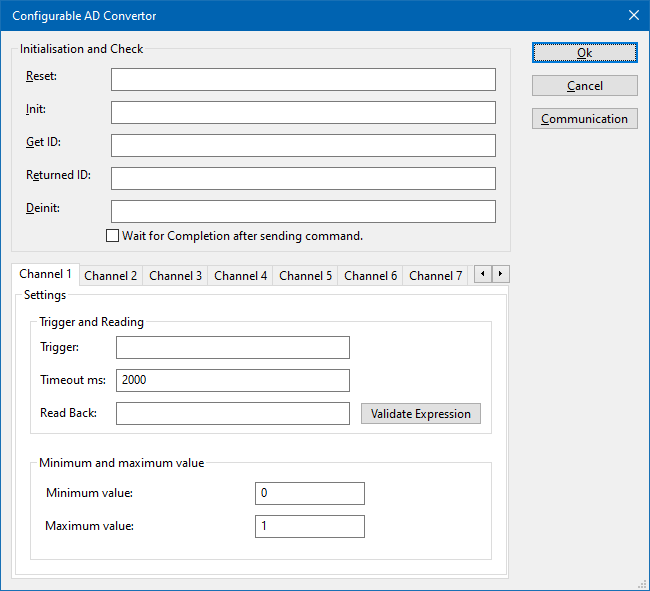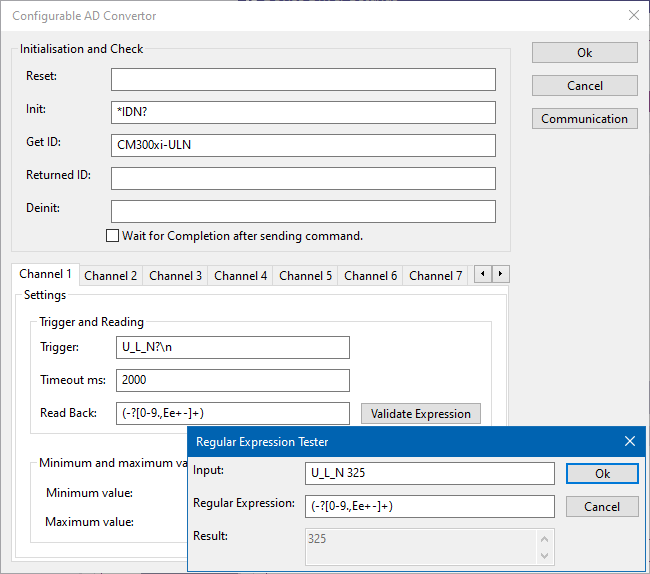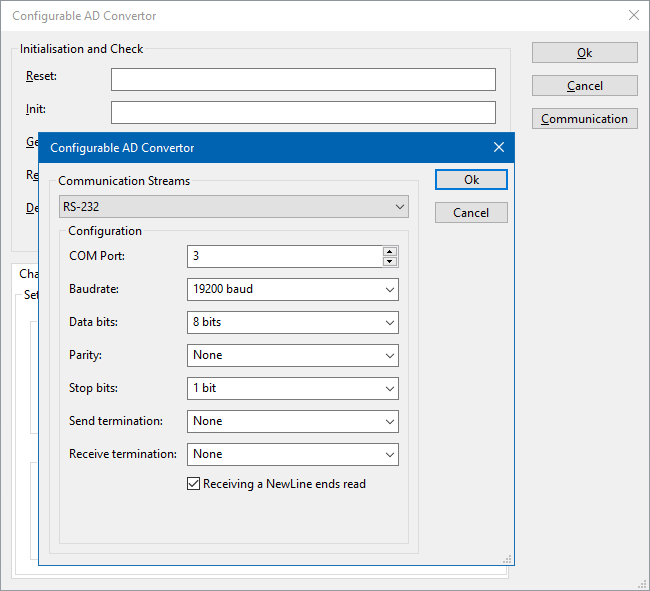Difference between revisions of "Configurable AD Convertor"
(→Initialisation and Check) |
|||
| Line 11: | Line 11: | ||
[[Image:Configurable AD Converter Configuration Window.png]] | [[Image:Configurable AD Converter Configuration Window.png]] | ||
| − | |||
| − | |||
| − | |||
| − | |||
| − | |||
| − | |||
| − | |||
== Initialisation and Check == | == Initialisation and Check == | ||
| Line 98: | Line 91: | ||
{{ScreenElementDescription|Result|The numerical value that is determined by the device driver using the {{ScreenElement|Regular Expression}} on the {{ScreenElement|Input}}.}} | {{ScreenElementDescription|Result|The numerical value that is determined by the device driver using the {{ScreenElement|Regular Expression}} on the {{ScreenElement|Input}}.}} | ||
{{ScreenElementDescriptionEnd}} | {{ScreenElementDescriptionEnd}} | ||
| + | |||
| + | == Communication == | ||
| + | Multiple communication types can be selected for the configurable AD convertor. Depending on the connection that is used, select the correct {{ScreenElement|Communication Stream}}, and configure the parameters correspondingly.</br> | ||
| + | Note that when the selected communication type does not have the option to change the termination character, it will be expected that a new line feed is send by the connected device apppended to each message. | ||
| + | |||
| + | [[File:ConfigureCommunication.png]] | ||
Revision as of 18:21, 30 January 2023
The Configurable AD Convertor device driver is a AD Converter which is supported by RadiMation®.
It can be used to control other measurement equipment, for which no RadiMation device driver is available yet. The Configurable AD Convertor allows to retrieve a measurement value from the measurement equipment, where the measured value can then be used in RadiMation as an EUT Monitoring input. These values can thus be measured and shown in graphs during immunity tests.
Initialisation and Check
The Configurable AD Convertor device driver has several boxes, in which the remote programming commands can be specified, which should be transmitted to the measurement device on defined moments.
| The reset code that needs to be transmitted to device. When left blank, no command will be transmitted. |
| The command that is transmitted to initialise the configured device. When left blank, no command will be transmitted. |
| The query-command that is transmitted to retrieve the ID of the device. This is used to check if the device is connected. A commonly used SCPI command is: '*IDN?'. When left blank, no command will be transmitted. |
| If the checkbox is ticked, RadiMation® will wait for all the commands to complete, before it continues. This is achieved by also transmitting the SCPI query-command '*OPC?' to the device, and waiting for the response. |
Channels
AD convertors can have multiple channels on which AD values could be read. The Configurable AD Convertor device driver is able to retrieve up to 40 measurement values from the measurement device. For each AD channel, individual commands can be set, specific for the values that should be retrieved.
Trigger and Reading
| A trigger command can be specified to request a measurement from the device. A commonly used SCPI command is: *TRG. When left blank, no command will be send. |
| Different measurement devices will return different messages that contain the measurement value. The configurable AD convertor only needs the numeric value of the measurement device response. The text that is specified in the Read Back box, is used as a regular expressions to determine the returned value.
A good regular expression for finding the first number in scientific notation in a text is: ([+-]?[0-9]*\.?[0-9]+([eE][+-]?[0-9]+)?) For more possibilities see the example section. |
Minimum and maximum value
The minimum and maximum must be set to calculate the raw AD convertor value to a digital value with a specific type.
| The lowest value that can be measured with this device. The value must be the same as filled in the EUT window. |
| The highest value that can be measured with this device. The value must be the same as filled in the EUT window. |
With minimum set to 0 and maximum set to 1, the raw value won't be converted, but instead directly used as it is included in the response.
Read Back examples
Some examples for interpreting a response are:
| Received information | Regular expression | Determined measurement value | Note |
|---|---|---|---|
| U_L_N 325 | (-?[0-9.,Ee-]+) | 325 | Takes the first number. |
| I_L1;12.34 | ;(-?[0-9.,Ee-]+) | 12.34 | Takes the first number after ";". |
| THD_U_L1;;14,5 | ;;(-?[0-9.,Ee-]+) | 14.5 | Takes the first number after ";;". |
| AC_FREQ;Channel1;1.23E3 | ;.*;(-?[0-9.,Ee-]+) | 1230 | Takes the first number after the appearance of a second ";". |
The correctness of the regular expression can be tested, verified and improved by using the Validate Expression tool within the configurable device driver.
In the Regular Expression Tester, the following fields are available to verify the regular expression:
| Any text that is expected to be returned by the device. |
| The Regular expression that is being tested. This regular expression will be used to use the text from Input and convert it into a numerical value. |
| The numerical value that is determined by the device driver using the Regular Expression on the Input. |
Communication
Multiple communication types can be selected for the configurable AD convertor. Depending on the connection that is used, select the correct Communication Stream, and configure the parameters correspondingly.
Note that when the selected communication type does not have the option to change the termination character, it will be expected that a new line feed is send by the connected device apppended to each message.


